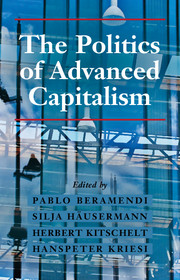Book contents
- Frontmatter
- Contents
- List of Figures
- List of Tables
- List of Contributors
- Preface
- 1 Introduction: The Politics of Advanced Capitalism
- PART I STRUCTURAL TRANSFORMATIONS
- Part II Politics
- 7 Party Alignments: Change and Continuity
- 8 What Do Voters Want? Dimensions and Configurations in Individual-Level Preferences and Party Choice
- 9 Trade Unions and the Future of Democratic Capitalism
- Part III Policies
- Part IV Outcomes
- Reference
- Index
7 - Party Alignments: Change and Continuity
from Part II - Politics
Published online by Cambridge University Press: 05 May 2015
- Frontmatter
- Contents
- List of Figures
- List of Tables
- List of Contributors
- Preface
- 1 Introduction: The Politics of Advanced Capitalism
- PART I STRUCTURAL TRANSFORMATIONS
- Part II Politics
- 7 Party Alignments: Change and Continuity
- 8 What Do Voters Want? Dimensions and Configurations in Individual-Level Preferences and Party Choice
- 9 Trade Unions and the Future of Democratic Capitalism
- Part III Policies
- Part IV Outcomes
- Reference
- Index
Summary
Changes in the occupational structure and political economy of advanced capitalism, explained in Daniel Oesch's chapter in this volume, and related shifts in the formation of political mass preferences, examined by Silja Häusermann and Hanspeter Kriesi in the subsequent chapter, are consequential for political partisan alignments, the subject of this chapter. As previously small occupational groups with distinct political preference profiles gained numerical weight in the electorate, particularly highly educated sociocultural professionals, established party families saw their vote shares decline, unless they modified their programmatic appeals. Established parties with new strategies or new party creations went on to capture novel voter coalitions, a process that has played out in cross-nationally diverse ways.
Shifts in electoral partisan coalitions coincided with (1) a steep decline in party membership; (2) a moderate to sharp increase in electoral volatility signaling the availability of more voters to competing party appeals; (3) a decline in voter turnout, as people no longer acted simply on parental party identifications or associational ties; and (4) a corresponding rise of nonpartisan social movements and interest groups. At least three rival theoretical arguments have claimed to make sense of party system change in postindustrial democracies, all consistent with these basic facts: the postindustrial realignment; the postindustrial dealignment; and the cartel party detachment perspectives. Examining empirical trends over time and cross-national variance among party systems, we conclude that a political realignment perspective explains observable patterns best.
Three Perspectives on Postindustrial Political Alignments
The disagreements on political alignments concern facts about the nature of citizen-politician linkages and causal mechanisms that produce them in postindustrial democracies. There are three prominent perspectives on this topic:
• Postindustrial Realignment (PiR): Voters continue to coalesce around parties on the basis of durable socioeconomic interests and policy preferences, but since political-economic postindustrialization, highlighted by changing occupational profiles, has changed the distribution of preferences, established parties have been compelled to alter their appeals or tolerate the electoral success of new parties that represent voter preferences ignored by established alternatives.
[…]
- Type
- Chapter
- Information
- The Politics of Advanced Capitalism , pp. 179 - 201Publisher: Cambridge University PressPrint publication year: 2015
- 34
- Cited by

